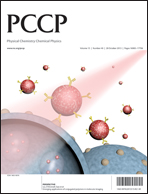Bubble bouncing at a clean water surface†
Abstract
Experiments on the coalescence time of submillimeter bubbles colliding with a distilled water/air interface either being at rest (undisturbed) or vibrating vertically (with controlled amplitude and frequency) were carried out. It was found that the outcome of the bubble collision (coalescence or bounce) depends on impact velocity and size of the bubble, i.e. the parameters determining the bubble deformation degree. With the surface at rest, when the deformation of the bubble was sufficiently high, bubble bouncing was observed. It was caused by the fact that the radius of the intervening liquid film formed between the colliding bubble and water/air interface was large enough to prevent the liquid layer from reaching its thickness of rupture within the time of bubble–interface contact. Coalescence occurred in a consecutive collision if the bubble deformation was below a threshold value, as a result of dissipation of the kinetic energy associated with the bubble motion. The hypothesis about the crucial role of the bubble deformation and size of the liquid film formed in the bouncing mechanism was confirmed in a series of experiments where the bubble collided with a vibrating water/air interface. It was shown that when the kinetic energy was properly re-supplied from an external source (interface vibrations), the spectacular phenomenon of “immortal” bubbles, dancing indefinitely at the water/air interface, was achieved. It was shown that “immortal” bubble formation is a consequence of a similarly high degree of the bubble shape deformation and consequently a large enough radius of the liquid film formed.


 Please wait while we load your content...
Please wait while we load your content...